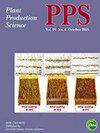咖啡(Coffea arabica L.)的环境互作基因型及产量稳定性在埃塞俄比亚西部进行了基因型评估
IF 1.3
3区 农林科学
Q2 AGRONOMY
引用次数: 0
摘要
摘要基因型在不同环境下的表现可以用来决定它们的适应性和稳定性。然而,关于咖啡基因型在各种环境条件下的表现的信息是有限的。因此,本研究的目的是通过环境相互作用(GEI)来估计基因型,评估埃塞俄比亚西部八个特色咖啡种植环境中16种果味咖啡基因型的平均性能和稳定性,并评估不同稳定性参数之间的相关性。实验采用随机完全区组设计(RCBD),两次重复。对于咖啡产量,记录数据,并进行方差分析和稳定性分析。加法主效应和乘法相互作用(AMMI)分析显示,基因型、环境和GEI对咖啡豆产量表现出高度显著的差异(P<0.01)。AMMI分析还显示,咖啡豆产量的GEI平方和的73.2%由前三个相互作用主成分轴(IPCA)决定。标准对照品种G16(Menesibu)、G3(W54/99)和G10(W107/99)在不同环境中每公顷清洁咖啡的平均产量最高,分别为1537、1458和1375公斤。尽管由于高GEI,没有基因型在整个环境中始终表现良好,但G1(W13/99)和G5(W54/99)相对稳定。因此,推荐将其作为高产基因型选育的有用遗传资源。然而,由于所有基因型的平均产量都低于标准对照品种,因此应在更多的环境中测试其他基因型,以开发稳定高产的咖啡品种。图形摘要本文章由计算机程序翻译,如有差异,请以英文原文为准。
Genotype by Environment Interaction and Yield Stability of Coffee (Coffea arabica L.) Genotypes Evaluated in Western Ethiopia
ABSTRACT The performance of genotypes under diverse environments can be used to determine their adaptability and stability. However, information on the performance of coffee genotypes in various environmental conditions is limited. Thus, this study’s objectives were to estimate genotype by environment interaction (GEI), evaluate the mean performance and stability of 16 fruity flavored coffee genotypes in eight specialty coffee growing environments in western Ethiopia, and assess the magnitude of correlations among different stability parameters. The experiment was laid out in a randomized complete block design (RCBD) with two replications. For coffee yield, data were recorded and a combined analysis of variance and stability analysis were performed. Additive main effect and multiplicative interaction (AMMI) analysis revealed that genotypes, environments, and GEI showed highly significant differences (P < .0.01) for coffee bean yield. AMMI analysis also revealed that 73.2% of the GEI sum of squares for coffee bean yield was accounted for by the first three interaction principal component axes (IPCA). The standard check variety G16 (Menesibu), G3(W54/99), and G10 (W107/99) gave the highest average yields of 1537, 1458 and 1375 kg of clean coffee per hectare across environments, respectively. Despite no genotypes consistently performing well across environments due to the high GEI, G1 (W13/99) and G5 (W54/99) were relatively stable. Therefore, these were recommended as useful genetic resources for breeding of high-yielding genotypes. However, since all the genotypes gave a mean yield below the standard check variety, additional genotypes should be tested in more environments to develop stable and high-yielding coffee varieties. Graphical abstract
求助全文
通过发布文献求助,成功后即可免费获取论文全文。
去求助
来源期刊

Plant Production Science
农林科学-农艺学
CiteScore
5.10
自引率
4.00%
发文量
27
审稿时长
>36 weeks
期刊介绍:
Plant Production Science publishes original research reports on field crops and resource plants, their production and related subjects, covering a wide range of sciences; physiology, biotechnology, morphology, ecology, cropping system, production technology and post harvest management. Studies on plant production with special attention to resource management and the environment are also welcome. Field surveys on cropping or farming system are also accepted. Articles with a background in other research areas such as soil science, meteorology, biometry, product process and plant protection will be accepted as long as they are significantly related to plant production.
 求助内容:
求助内容: 应助结果提醒方式:
应助结果提醒方式:


